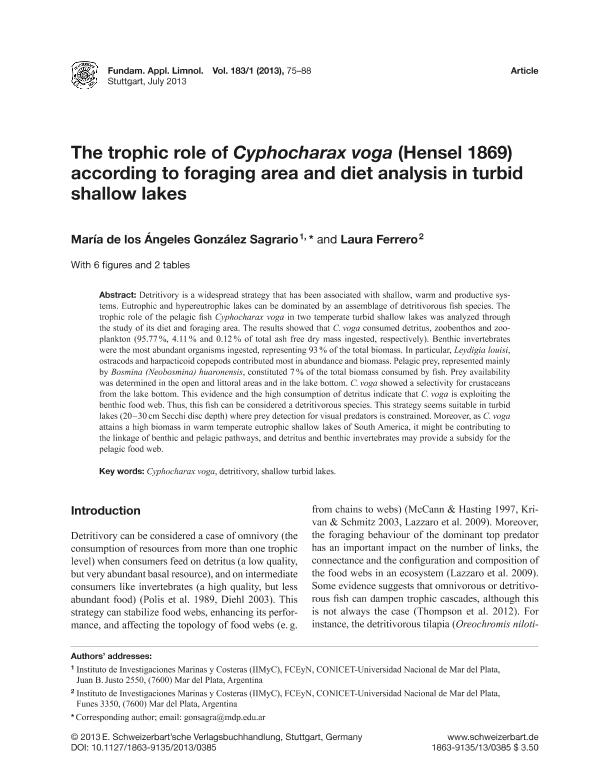Artículo
The trophic role of Cyphocharax voga (Hensel 1869) according to foraging area and diet analysis in turbid shallow lakes
Fecha de publicación:
08/2013
Editorial:
E Schweizerbartsche Verlags
Revista:
Fundamental And Applied Limnology
ISSN:
1863-9135
Idioma:
Inglés
Tipo de recurso:
Artículo publicado
Clasificación temática:
Resumen
Detritivory is a widespread strategy that has been associated with shallow, warm and productive systems. Eutrophic and hypereutrophic lakes can be dominated by an assemblage of detritivorous fish species. The trophic role of the pelagic fish Cyphocharax voga in two temperate turbid shallow lakes was analyzed through the study of its diet and foraging area. The results showed that C. voga consumed detritus, zoobenthos and zooplankton (95.77 %, 4.11 % and 0.12 % of total ash free dry mass ingested, respectively). Benthic invertebrates were the most abundant organisms ingested, representing 93 % of the total biomass. In particular, Leydigia louisi, ostracods and harpacticoid copepods contributed most in abundance and biomass. Pelagic prey, represented mainly by Bosmina (Neobosmina) huaronensis, constituted 7 % of the total biomass consumed by fish. Prey availability was determined in the open and littoral areas and in the lake bottom. C. voga showed a selectivity for crustaceans from the lake bottom. This evidence and the high consumption of detritus indicate that C. voga is exploiting the benthic food web. Thus, this fish can be considered a detritivorous species. This strategy seems suitable in turbid lakes (20 – 30 cm Secchi disc depth) where prey detection for visual predators is constrained. Moreover, as C. voga attains a high biomass in warm temperate eutrophic shallow lakes of South America, it might be contributing to the linkage of benthic and pelagic pathways, and detritus and benthic invertebrates may provide a subsidy for the pelagic food web.
Palabras clave:
Cyphocharax Voga
,
Detritivory
,
Shallow Turbid Lakes
Archivos asociados
Licencia
Identificadores
Colecciones
Articulos(IIMYC)
Articulos de INSTITUTO DE INVESTIGACIONES MARINAS Y COSTERAS
Articulos de INSTITUTO DE INVESTIGACIONES MARINAS Y COSTERAS
Citación
Gonzalez Sagrario, Maria de Los Angeles; Ferrero, Laura; The trophic role of Cyphocharax voga (Hensel 1869) according to foraging area and diet analysis in turbid shallow lakes; E Schweizerbartsche Verlags; Fundamental And Applied Limnology; 183; 1; 8-2013; 75-88
Compartir
Altmétricas




